工业工程技术培训01 Word 文档
- 格式:docx
- 大小:1.31 MB
- 文档页数:31
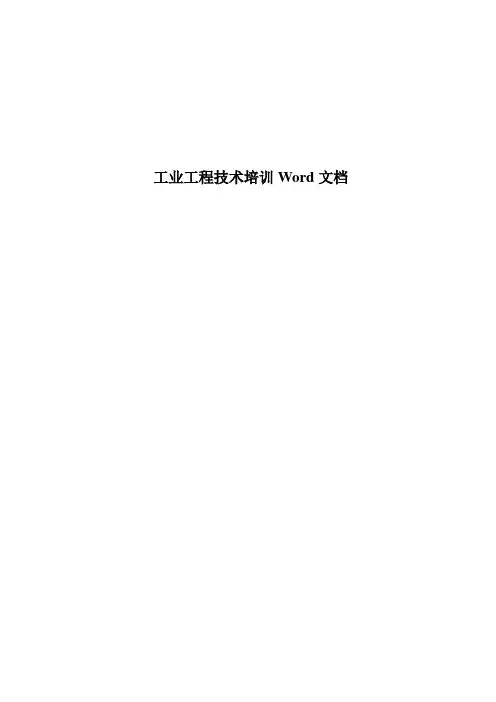
工业工程技术培训Word文档一、工业工程(I E-Industrial Engineering)的内涵与应用二、标准工时结构分析三、时间衡量系统介绍四、疲劳或者休息宽放(Fatigue or Rest Allowance)之订定五、工业工程之常用工具3 3 5 6 9 9 9 11 11 11 14 16 1616171718 21 24 273233 36 42 49一、工业工程(I E-Industrial Engineering)的内涵与应用(一)工业工程之定义与内涵Industrial Engineering is concerned with the design, improvement, and installation of integrated systems of people, materials, information, equipment, and energy. It draws upon specialized knowledge and skill in the mathematical, physical, and social sciences together with the principles and methods of engineering analysis and design to specify, predict, and evaluate the results to be obtained from such systems.~ IIE-Institute of Industrial Engineering ~美国工业工程协会之定义:工业工程系有关设计、改进及建立包含人员、物料、信息、设备、能源的整合系统;其系利用数学、物理学、社会科学中的专门知识与技术与工程分析、工程设计的原理与方法,去确立、预测及评估系统之结果。
Contents of Systems designed by Industrialand system engineer*Human Activity System1) The manufacturing process itself (or processingprocedures of a service organization).2) Materials.3) Machine and equipment.4) Methods by which workers perform tasks.5) Layout of facilities and specification of material flow.6) Material handling equipment and procedures.7) Workplace design.8) Storage space size and location.9) Data recording procedures for management reporting.10) Procedures for maintenance and housekeeping.11) Safety procedures.*Management Control System1) Management planning system.2) Forecasting procedures.3) Budgeting and economic analyses.4) Wage and salary plans.5) Incentive plans and other employee relations systems.6) Recruiting, training, and other placement of employees.7) MRP-Materials requirement planning.8) Inventory control procedures.9) Production scheduling.10) Dispatching.11) Progress and status reporting.12) Corrective action procedures.13) Overall information system.14) Quality control system.15) Cost control and reduction.16) Resources allocation.17) Organization design.(二)IE 机制建立(a) 基本业务(Primary Activities)(b) 工程业务(Engineering Activities)(c) 咨询业务(Consultation Activities)An Overview of IE-Industrial Engineering(三)、IE Operating Function & Basic Training 1. 制程设计‧产品组合分析‧作业工时分析: 码表测时、评比、RWF‧Tact Time(T.T.)订定‧作业人力与工作站需求计算‧工作站作业内容设计与作业标准工时订定‧生产线平衡‧治具、工具、夹具设计‧工作站布置设计:人因工程学(Ergonomics)、动作经济原则2. 流程设计‧工厂布置(生产区、仓库区、厂房设施、办公室、信道、其它区域):SLP-Systematic Layout Planning 、SHP-Systematic Handling Planning‧动线设计(人流、物流)‧物料传送系统(Materials Transport System):传送设备、传送人力、传送频率‧动力传送系统:压缩空气、电力、生产用水、生产用气体、生产用油料‧厂务设施系统:空调、广播、废气排放、废料处理、接地导电、噪音防治、信号、通讯、网络3. 标准成本设定‧产能设定:生产设备/设备工时总需求量与、作业人力/作业工时总需求量‧预算编列‧工时费用率订定:机器设备工时、作业员工时、研发工时、其它服务工时‧技术资料订定:机器设备效率、作业员效率、产品标准工时(机器设备工时、作业员工时)、产品收成率、产品不良率、工时宽放率、非生产性工时‧材料标准成本‧创始成本(Initial Cost)分摊率订定: 研发成本、专用设备成本、专用模具成本4. 投资决策评估‧工程经济‧Decision Calculation5. 经营管理‧绩效分析与管制(PAC-Performance Analysis and Control)‧绩效奖励制度‧提案(建议案)制度‧稼动率(操动率)管理‧PPS-Philips Production System‧Layout Planning and Material Handling System‧生产力评估系统6. 经营管理改善‧价值分析/价值工程(VA/VE-Value Analysis and ValueEngineering)‧工作分析与改善‧流程分析与改善‧Layout/Material Handling分析与改善‧装配性评估与改善(DFA-Design For Assembly): 人工装配、自动化装配‧职务分析与改善: 负荷分析、职务分配、工作改善、流程改善‧组织价值分析(ORVA-Organization Value Analysis)与改善‧组织结构分析与改善: 组织层级、管理幅度‧组织气候调查(士气调查)与改善‧作业研究(O.R.-Operations Research)‧Supply Chain/Value Chain 分析与改善二、标准工时结构分析 (一)E-system正常速度60单位(Normal speed/tempo 60 E ) 是指一个作业人员依照下图之方式执行其工作也就是说在一小时(钟表时间)内其总工作内容(Work Content )或者工作量为60分钟,其中包含54.5分钟的操作(Operation )与5.5分钟的休息疲劳宽放(Rest/Fatigue Allowance )。
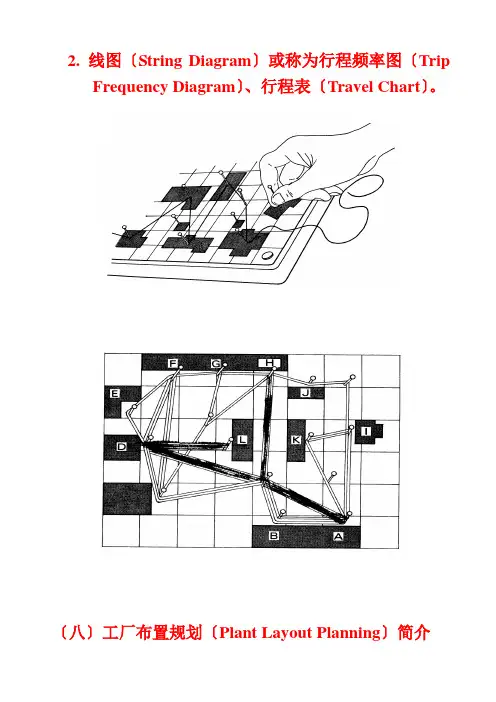
2. 线图〔String Diagram〕或称为行程频率图〔TripFrequency Diagram〕、行程表〔Travel Chart〕。
〔八〕工厂布置规划〔Plant Layout Planning〕简介1. 工厂布置之规划程序2. 工厂布置规划之根底信息3. 工厂布置之型态4. 关连图(Relationship Diagram)5. 关连分析 (Relationship Analysis)6. 工厂布置之着眼点◎人性化观点:〝人、机、物〞之和谐关系◎平安性之设计考量◎生产性观点:〝人、机、物〞之最适组合‧流动程序(Flow process) 、动线:Ship-To-Store, Ship-To-Line , Make-TO-Shipment, Make-To-Order, etc.‧流动频率:JIT-Just in time‧Load & Unload之次数/频率‧搬运设备之效能〔九〕缩短换线换模时间之要领简介Improvement Approach 改善的手法☆Four ( 4 ) Steps 四个步骤☆Two ( 2 ) Categories 两种类别☆Four ( 4 ) Stages 四个阶段4 Steps〔四个步骤〕☆Preparation〔准备〕☆(Re)placement 〔更换、装置〕☆Adjustment 〔调整〕☆Completion 〔完成、善后〕Step 1 Preparation〔准备〕*Drawing Up Change-over Instructions.- Operations.- Tools needed (jigs, dies, moulds, etc.).- Fasteners needed (bolts, screws, washers, nuts, clamps,clips, etc.).*Storage, Maintenance and Inspection of Tools and Fasteners.*Gathering and Preparation of New Tools and Fasteners. Transport of Tools and Fasteners to the Process.Step 2 (Re)placement〔更换、装置〕*Unfastening and Removal of Old Tools.*Placing the New Tools.*Centering the New Tools.Step 3 Adjustment〔调整〕*Fastening New Tools.*Securing the New Tools.*Adjustment of the New Tools.Step 4 Completion〔完成、善后〕*Transport of Old Tools.*Cleaning, Greasing and Oiling The Old Tools.*Storage of Old Tools.2 Categories〔两种类别〕☆On-line Change-over〔线内更换〕Change-over activities Interrupting the process.☆Off-line Change-over〔线外更换〕Change-over activities alongside the process.Producingproduct B4 Stages 〔四个阶段〕◎ Intermingled Stage 〔混合阶段〕* No separation between.* On-line and off-line operations.* Process is stopped during total change.* New tools are brought in after the process has beenstopped.* Neither tools nor fasteners are properly maintained,checked or prepared.* Tools and fasteners are not tidy stored.◎ Separated Stage 〔别离阶段〕Producing product B Off-line*On-line and off-line operations are kept separated.*Process is stopped for on-line operations only.*All necessary preparations are completed while the process is going on.* A checklist is available for carrying out off-line work.*Maintenance, inspection and preparation of tools and fasteners are carried out off-line.* A check is made whether tools and fasteners work properly.◎Transferred Stage〔移转阶段〕*On-line operations are transferred to off-line as much as possible.*Height of dies, rams and press blocks are standardized.*All fasteners and spanners are standardized.*Standardized intermediate attachments are introduced.*Adjustment of machines strokes is avoided.◎Advanced Stage〔改良阶段〕*Both on-line and off-line operations are minimized.*Dimensions of all tools are standardized.*Handling of moulds, jigs, dies and forms is standardized. *Hydraulic, pneumatic or magnetic fastening is introduced. *Fastening and adjustment work is simplified or eliminatedwherever possible.*Cassettes are introduced.◎From Intermingled to Separated Stage*Make a clear description of all change-over operations to be executed today (see worksheet).*Prepare a summary list of :- all tools needed (jigs, dies, moulds, etc.).- all fasteners needed (bolts, screws, clips, etc.).*Classify all operations into:- off-line activities.- on-line activities.◎From Separated to Transferred Stage*Transfer operations from on-line to off-line as much as possible.*The use of functional fasteners.*The previous installation of intermediate attachments, bolsters and fasteners.*Introduction of functional dial or pointer readings.◎From Transferred to Advanced Stage*Improvement of handling, transport and storage methods. *The use of hydraulic, pneumatic or magnetic methods for placing and/or fastening tools.*The elimination of centering and adjustment activities by standardisation of:- dimension of moulds.- machine strokes.- male and female jigs.- centering and fastening methods.*Improve measuring and gauging methods.*Elimination of trial runs.〔十〕I E 改善心法Ways of Improving the Work Through Motion Study- EASIER WAY- approachE liminate unnecessary motionsA void moves requiring eye direction S horten motion distanceI mprove "get" motions by pre-positioning E mploy simple fixtures, clamps, and guidesR eplace hand operations with foot-operated devicesW hy ? Question each operation A dapt two-hand methodY es, there is always room for improvement〔三〕改善之要诀:ECRS 、6W‧删除〔Elimination 〕:删除不必要的作业或动作‧合并〔Combination 〕:将数个作业或动作合并,省略转交或取放。
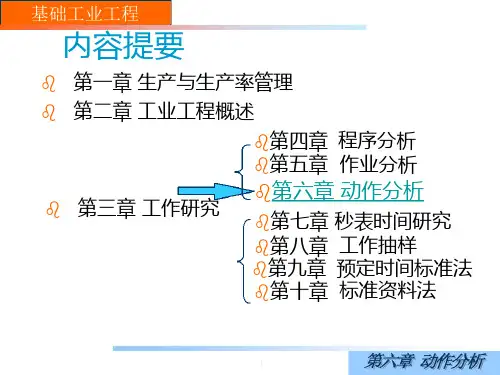
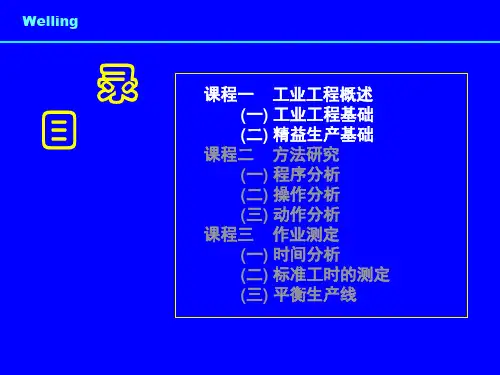
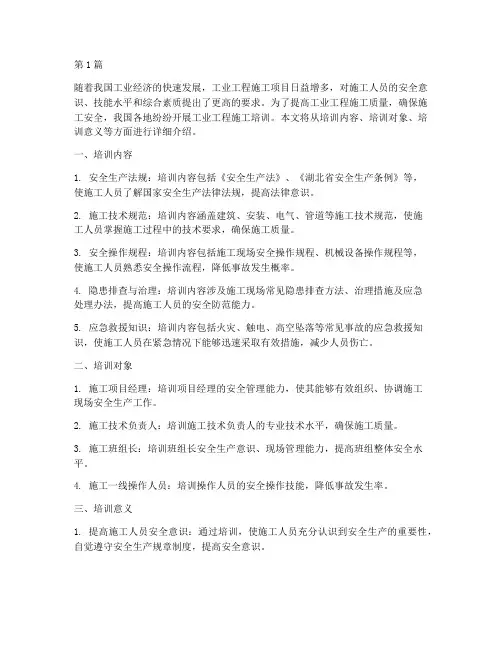
第1篇随着我国工业经济的快速发展,工业工程施工项目日益增多,对施工人员的安全意识、技能水平和综合素质提出了更高的要求。
为了提高工业工程施工质量,确保施工安全,我国各地纷纷开展工业工程施工培训。
本文将从培训内容、培训对象、培训意义等方面进行详细介绍。
一、培训内容1. 安全生产法规:培训内容包括《安全生产法》、《湖北省安全生产条例》等,使施工人员了解国家安全生产法律法规,提高法律意识。
2. 施工技术规范:培训内容涵盖建筑、安装、电气、管道等施工技术规范,使施工人员掌握施工过程中的技术要求,确保施工质量。
3. 安全操作规程:培训内容包括施工现场安全操作规程、机械设备操作规程等,使施工人员熟悉安全操作流程,降低事故发生概率。
4. 隐患排查与治理:培训内容涉及施工现场常见隐患排查方法、治理措施及应急处理办法,提高施工人员的安全防范能力。
5. 应急救援知识:培训内容包括火灾、触电、高空坠落等常见事故的应急救援知识,使施工人员在紧急情况下能够迅速采取有效措施,减少人员伤亡。
二、培训对象1. 施工项目经理:培训项目经理的安全管理能力,使其能够有效组织、协调施工现场安全生产工作。
2. 施工技术负责人:培训施工技术负责人的专业技术水平,确保施工质量。
3. 施工班组长:培训班组长安全生产意识、现场管理能力,提高班组整体安全水平。
4. 施工一线操作人员:培训操作人员的安全操作技能,降低事故发生率。
三、培训意义1. 提高施工人员安全意识:通过培训,使施工人员充分认识到安全生产的重要性,自觉遵守安全生产规章制度,提高安全意识。
2. 提升施工技能水平:培训内容涵盖了施工过程中的关键技术要求,使施工人员掌握专业技能,提高施工质量。
3. 降低事故发生率:通过培训,提高施工人员的安全防范能力,降低施工现场事故发生率。
4. 促进企业安全稳定发展:培训有助于企业建立健全安全生产管理体系,提高企业整体安全水平,为企业安全稳定发展奠定基础。

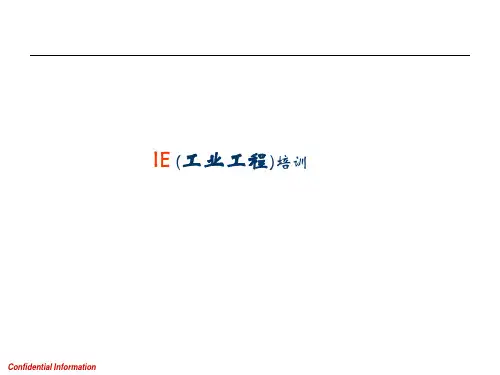
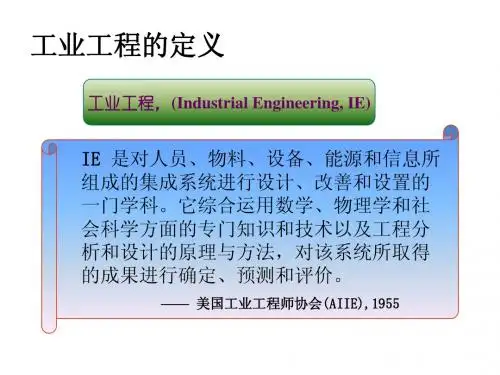
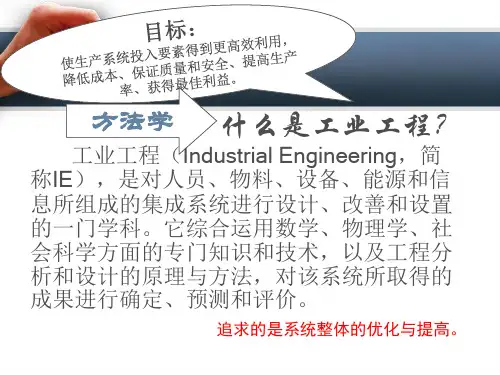
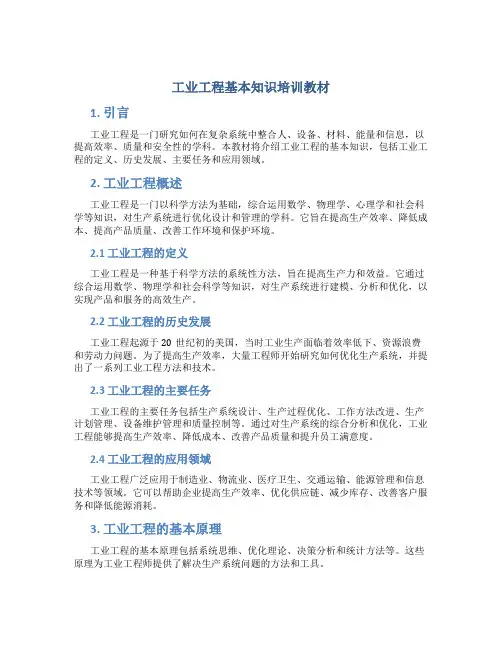
工业工程基本知识培训教材1. 引言工业工程是一门研究如何在复杂系统中整合人、设备、材料、能量和信息,以提高效率、质量和安全性的学科。
本教材将介绍工业工程的基本知识,包括工业工程的定义、历史发展、主要任务和应用领域。
2. 工业工程概述工业工程是一门以科学方法为基础,综合运用数学、物理学、心理学和社会科学等知识,对生产系统进行优化设计和管理的学科。
它旨在提高生产效率、降低成本、提高产品质量、改善工作环境和保护环境。
2.1 工业工程的定义工业工程是一种基于科学方法的系统性方法,旨在提高生产力和效益。
它通过综合运用数学、物理学和社会科学等知识,对生产系统进行建模、分析和优化,以实现产品和服务的高效生产。
2.2 工业工程的历史发展工业工程起源于20世纪初的美国,当时工业生产面临着效率低下、资源浪费和劳动力问题。
为了提高生产效率,大量工程师开始研究如何优化生产系统,并提出了一系列工业工程方法和技术。
2.3 工业工程的主要任务工业工程的主要任务包括生产系统设计、生产过程优化、工作方法改进、生产计划管理、设备维护管理和质量控制等。
通过对生产系统的综合分析和优化,工业工程能够提高生产效率、降低成本、改善产品质量和提升员工满意度。
2.4 工业工程的应用领域工业工程广泛应用于制造业、物流业、医疗卫生、交通运输、能源管理和信息技术等领域。
它可以帮助企业提高生产效率、优化供应链、减少库存、改善客户服务和降低能源消耗。
3. 工业工程的基本原理工业工程的基本原理包括系统思维、优化理论、决策分析和统计方法等。
这些原理为工业工程师提供了解决生产系统问题的方法和工具。
3.1 系统思维工业工程是一门系统工程学科,强调整体观念和系统思维。
工业工程师需要将生产系统看作一个整体,并综合考虑各个组成部分之间的关系和相互作用。
3.2 优化理论优化理论是工业工程的核心方法之一,旨在找到使生产系统达到最佳状态的方法和策略。
常用的优化方法包括线性规划、整数规划、动态规划和遗传算法等。

工业工程基本知识培训1. 前言工业工程是一门综合性的学科,旨在提高组织和系统运作的效率和效益。
本文档旨在介绍工业工程的基本知识,帮助读者了解这门学科的重要概念和技术。
2. 工业工程概述工业工程是一门应用科学,主要关注如何最大限度地提高组织和系统的效率、效益和质量。
它综合运用数学、统计学、工程和管理学的原理和方法,通过优化流程和资源分配来改进组织和系统的运作。
工业工程的核心目标是在保证产品和服务质量的前提下,实现成本最小化和资源最优化。
3. 工业工程的基本原则工业工程的实践基于一些基本原则,包括:•系统思维:将组织或系统视为一个整体,关注不同部分之间的相互影响和依赖关系。
•经济性原则:追求在资源有限的情况下实现最优解,既要确保产品和服务的质量,又要控制成本。
•增值原则:通过优化价值流程,使每个环节都为最终用户创建价值。
•持续改进:在不断地改进中追求卓越,通过减少浪费和提高效率来不断提升组织和系统的绩效。
4. 工业工程的关键技术4.1 运筹学运筹学是工业工程的核心技术之一,主要包括线性规划、整数规划、动态规划和排队论等方法。
它的目标是在资源有限的情况下实现最优解,通过数学模型和优化算法来解决生产、运输、库存等方面的问题。
4.2 人因工程人因工程关注人的工作活动和工作环境之间的适应性。
它研究如何设计出符合人体工程学原理的工作环境,提高操作者的工作效率和工作质量,并减少因工作而导致的健康问题。
4.3 设施布局设施布局涉及如何在有限的空间内合理安排设备、工作区和设施。
通过优化空间利用和减少运输时间,设施布局可以提高生产效率和员工的工作舒适度。
4.4 生产管理生产管理包括生产计划、生产调度、生产控制和质量控制等方面。
通过合理的生产管理,可以实现生产过程的协调和优化,确保产品质量和交付时间的准确性。
4.5 质量管理质量管理是为了满足产品或服务的设计要求而采取的一系列措施。
它包括质量规划、质量控制和质量改进等方面,通过建立适当的质量管理体系,提高产品和服务的质量,减少质量问题和成本。
工业工程技术培训教程引言工业工程是一门将工程技术应用于工业领域的学科,旨在提高生产效率和质量、优化资源利用和管理,以及提升企业竞争力。
本教程将介绍工业工程的基本概念、方法和技术,以及其在生产制造、供应链管理和项目管理等领域的应用。
1. 工业工程概述工业工程是一门综合性学科,涵盖了工程学、管理学和行为科学等多个领域的知识和技术。
它以系统思维为基础,通过分析和优化各种流程和系统,实现生产效率的提高和资源的最优配置。
工业工程的主要目标包括: - 提高生产效率:通过优化生产流程、改善工作方法和提升员工技能,实现产品和服务的高质量、高效率产出。
- 优化资源利用:通过合理规划和管理资源,最大限度地提高资源的利用效率,降低成本和浪费。
- 改善人机环境:通过设计符合人体工程学原理的工作环境和设备,提高员工的工作安全性和舒适度,减少工伤和疲劳。
- 提升企业竞争力:通过改善生产和管理系统,提高产品质量、缩短交货周期和降低成本,增强企业在市场竞争中的优势。
2. 工业工程方法与技术2.1 生产系统分析生产系统分析是工业工程的核心内容之一。
它通过对生产流程、设备和人员的分析,识别瓶颈和问题,并提出改进措施。
常用的分析工具包括:- 流程图:用于描述生产过程中各个环节之间的关系和流程。
- 价值流图:用于分析产品和信息在整个价值链中的流动,找出浪费和改进机会。
- 工作测量:通过观察和记录员工的工作活动,分析工作时间、动作和动作序列,识别工作中的浪费和瓶颈。
2.2 设计工作系统设计工作系统是为了提高员工的工作效率和满意度。
它包括:- 工作站设计:通过合理配置工作站、工具和设备,减少员工的移动和体力劳动,提高工作效率。
- 人体工程学设计:根据人体结构和功能特点,设计符合人体工程学原理的工作环境和设备,降低员工的工作负担和健康风险。
- 工作安排与平衡:根据工作的性质和要求,合理安排员工的工作时间和任务分配,实现工作负荷的均衡和生产的连续性。
工业工程基础知识培训教材1. 引言工业工程是一门运用科学原理与数学方法来设计、改进和优化生产系统的学科。
它致力于提高生产效率、降低成本、优化资源利用率,并在生产系统中实现更高水平的质量和效益。
本教材旨在为初学者提供工业工程基础知识的全面介绍,帮助他们快速入门并理解工业工程的核心原理和应用场景。
2. 工业工程概述工业工程是一门综合性学科,涉及范围广泛。
在本章中,我们将介绍工业工程的定义、发展历程和应用领域,并解释工业工程在企业运营中的重要性。
2.1 工业工程定义工业工程是一门科学和工程学科,它使用数学、物理学和社会科学等学科的知识和技术,以设计、改进和优化整个生产系统为主要目标。
2.2 工业工程发展历程工业工程的起源可以追溯到19世纪末和20世纪初的美国。
随着工业化的发展,生产过程中出现了诸多问题,例如生产效率低下、资源浪费和质量问题。
工业工程学家通过研究和实践,逐渐发展出了一套科学的方法论和技术工具,用于解决这些问题。
2.3 工业工程应用领域工业工程的应用领域广泛,包括制造业、物流和供应链管理、项目管理、医院管理等。
在本节中,我们将重点介绍工业工程在制造业中的应用,以及它对企业效益和竞争力的影响。
3. 工业工程核心原理工业工程的核心原理是通过优化资源配置和工作流程,提高生产效率和质量。
在本章中,我们将详细介绍以下几个核心原理:3.1 工序分析工序分析是指对工作流程进行分解、分析和改进的过程。
通过对每个工序的详细分析,可以发现潜在的瓶颈和浪费,从而采取措施进行优化。
3.2 设备配置设备配置是指将不同的设备按照合理的规划和布局进行安排,以提高生产效率和资源利用率。
在本节中,我们将介绍一些常用的设备配置方法和技术。
3.3 作业调度作业调度是指合理安排生产作业的顺序和时间,以最大化生产效率和满足客户需求。
在本节中,我们将介绍一些常用的作业调度算法和策略。
3.4 质量管理质量管理是工业工程中至关重要的一环。
2. 线图(String Diagram)或称为行程频率图(TripFrequency Diagram)、行程表(Travel Chart)。
(八)工厂布置规划(Plant Layout Planning)简介1. 工厂布置之规划程序2. 工厂布置规划之基础信息3. 工厂布置之型态4. 关连图 (Relationship Diagram)5. 关连分析 (Relationship Analysis)6. 工厂布置之着眼点◎人性化观点:〝人、机、物〞之和谐关系◎安全性之设计考量◎生产性观点:〝人、机、物〞之最适组合‧流动程序(Flow process) 、动线: Ship-To-Store, Ship-To-Line , Make-TO-Shipment,Make-To-Order, etc.‧流动频率:JIT-Just in time‧Load & Unload之次数/频率‧搬运设备之效能(九)缩短换线换模时间之要领简介Improvement Approach 改善的手法☆ Four ( 4 ) Steps 四个步骤☆ Two ( 2 ) Categories 两种类别☆ Four ( 4 ) Stages 四个阶段4 Steps(四个步骤)☆ Preparation(准备)☆ (Re)placement (更换、装置)☆ Adjustment (调整)☆ Completion (完成、善后)Step 1 Preparation(准备)* Drawing Up Change-over Instructions.- Operations.- Tools needed (jigs, dies, moulds, etc.).- Fasteners needed (bolts, screws, washers, nuts, clamps, clips,etc.).* Storage, Maintenance and Inspection of Tools and Fasteners.* Gathering and Preparation of New Tools and Fasteners.Transport of Tools and Fasteners to the Process.Step 2 (Re)placement(更换、装置)* Unfastening and Removal of Old Tools.* Placing the New Tools.* Centering the New Tools.Step 3 Adjustment(调整)* Fastening New Tools.* Securing the New Tools.* Adjustment of the New Tools.Step 4 Completion(完成、善后)* Transport of Old Tools.* Cleaning, Greasing and Oiling The Old Tools.*Storage of Old Tools.2 Categories(两种类别)☆ On-line Change-over(线内更换)Change-over activities Interrupting the process.☆ Off-line Change-over(线外更换)Change-over activities alongside the process.Producingproduct B4 Stages (四个阶段)◎ Intermingled Stage (混合阶段)* No separation between.* On-line and off-line operations. * Process is stopped during total change.* New tools are brought in after the process has been stopped. * Neither tools nor fasteners are properly maintained, checked orprepared.* Tools and fasteners are not tidy stored.◎ Separated Stage (分离阶段)* On-line and off-line operations are kept separated.Producing product B Off-line* Process is stopped for on-line operations only.* All necessary preparations are completed while the process is going on.* A checklist is available for carrying out off-line work.* Maintenance, inspection and preparation of tools and fasteners are carried out off-line.* A check is made whether tools and fasteners work properly.◎ Transferred Stage(移转阶段)* On-line operations are transferred to off-line as much as possible.* Height of dies, rams and press blocks are standardized.* All fasteners and spanners are standardized.* Standardized intermediate attachments are introduced.* Adjustment of machines strokes is avoided.◎ Advanced Stage(改进阶段)* Both on-line and off-line operations are minimized.* Dimensions of all tools are standardized.* Handling of moulds, jigs, dies and forms is standardized.* Hydraulic, pneumatic or magnetic fastening is introduced.* Fastening and adjustment work is simplified or eliminated wherever possible.* Cassettes are introduced.◎ From Intermingled to Separated Stage* Make a clear description of all change-over operations to be executed today (see worksheet).* Prepare a summary list of :- all tools needed (jigs, dies, moulds, etc.).- all fasteners needed (bolts, screws, clips, etc.).* Classify all operations into:- off-line activities.- on-line activities.◎ From Separated to Transferred Stage* Transfer operations from on-line to off-line as much as possible.* The use of functional fasteners.* The previous installation of intermediate attachments, bolsters and fasteners.* Introduction of functional dial or pointer readings.◎ From Transferred to Advanced Stage* Improvement of handling, transport and storage methods.* The use of hydraulic, pneumatic or magnetic methods for placing and/or fastening tools.*The elimination of centering and adjustment activities by standardisation of:- dimension of moulds.- machine strokes.- male and female jigs.- centering and fastening methods.* Improve measuring and gauging methods.* Elimination of trial runs.(十)I E 改善心法Ways of Improving the Work Through Motion Study- EASIER WAY- approachE liminate unnecessary motionsA void moves requiring eye directionS horten motion distanceI mprove "get" motions by pre-positioning E mploy simple fixtures, clamps, and guidesR eplace hand operations with foot-operated devicesW hy ? Question each operation A dapt two-hand methodY es, there is always room for improvement(三)改善之要诀:ECRS 、6W‧删除(Elimination ):删除不必要的作业或动作‧合并(Combination ):将数个作业或动作合并,省略转交或取放。
‧重排(Re-arrangement ):将数个作业或动作重新安排,使作业或动作能平衡顺畅。